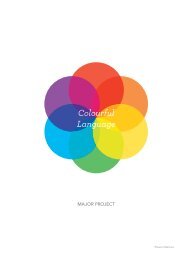Supporting Material Vol 1 - Colourful Language
Supporting Material Vol 1 - Colourful Language
Supporting Material Vol 1 - Colourful Language
Create successful ePaper yourself
Turn your PDF publications into a flip-book with our unique Google optimized e-Paper software.
Key Research<br />
Do You See What I See? by Beau Lotto<br />
Roses are red, violets are blue - or are they? The colours<br />
you see may not always be the same as the colours<br />
someone else sees… as we see colour through our<br />
brains, not our eyes. Neuroscientist Beau Lotto explains.<br />
Colour is one of our simplest sensations… even jellyfish<br />
detect light and they do not have a brain. And yet<br />
to explain lightness, and colour more generally, is to<br />
explain how and why we see what we do.<br />
The first thing to remember is that colour does not<br />
actually exist… at least not in any literal sense. Apples<br />
and fire engines are not red, the sky and sea are not<br />
blue, and no person is objectively “black” or “white”.<br />
What exists is light. Light is real.<br />
You can measure it, hold it and count it (well … sort-of).<br />
But colour is not light. Colour is wholly manufactured by<br />
your brain.<br />
How do we know this? Because one light can take on<br />
any colour… in our mind.<br />
Here’s another example. If you look at the cubes to the<br />
right, notice the four grey tiles on the top surface of<br />
the left cube and the seven grey tiles on the equivalent<br />
surface of the right cube.<br />
Once you’ve convinced yourself that these tiles are all<br />
physically the same colour (because they are), look at<br />
the next image down.<br />
What’s amazing is that now the grey tiles on the left<br />
look blue, whereas the same grey tiles on the right look<br />
yellow. The yellow and blue tiles of the two cubes share<br />
the same light, and yet look very different.<br />
Colour Memories<br />
Colour is arguably our best creation, one that is created<br />
according to our past experiences.<br />
his is why you see optical illusions, because when<br />
looking at an image that is consistent with your past<br />
experience of “real life”, your brain behaves as if the<br />
objects in the current images are also real in the same<br />
way.<br />
If we are using past experience to make sense of light,<br />
how quickly can we learn to see light differently? It is a<br />
matter of seconds. To demonstrate this we had a large<br />
group of people for Horizon try an illusion.<br />
First notice that the two desert scenes have exactly the<br />
same colour composition. The skies are both blueish<br />
and the deserts are both yellowish.<br />
However, when you stare at the dot between the red<br />
and green squares for 60 seconds, and then look back<br />
at the dot between the two desert scenes, the colours<br />
of the two identical scenes will astound you.<br />
The more focused you are in staring at the dot between<br />
the green and red squares the better the subsequent<br />
illusion will be.<br />
The desert scenes change colour because your brain<br />
incorporated its recent history of redness on the left and<br />
greenness on the right in the second image and applied<br />
it to the desert scenes when you looked at them for the<br />
second time … at least for a while.<br />
These two facts raise an intriguing possibility. Maybe<br />
colour is more fundamental to our sense of self than we<br />
thought previously. And indeed it is.<br />
Remember, colour has been at the heart of evolution for<br />
millions of years.<br />
Think of the relationship between insects and flowers<br />
(flowers are not coloured for our benefit, but for theirs),<br />
or of all the different colours of animals and how they<br />
either blend into their environment or, like the peacock,<br />
stand out in order to attract attention.



